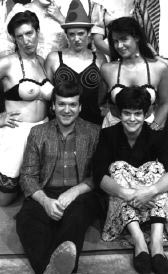WHY DOES A GIFTED young theater artist who’s successfully made the break from the bush leagues to the majors choose to return to her hometown just as her career’s taking off?
For Allison Narver, who takes over April 1 as artistic director of the Empty Space Theater, one reason’s right out of the professional playbook: No freelance director, however talented, gets a shot at running a big-budget theater until they’ve shown what they can do with a small one. Another reason is personal: Seattle’s a less stressful environment than New York for a two-career couple with a newborn daughter.
Nevertheless, the biggest reason for Narver’s return is probably aesthetic. How can you resist an offer to give new inspiration and direction to the very company that initiated you to the wonders of theater in the first place? “I think I was 8 when a girlfriend and I went over to Volunteer Park one weekend, and there was a performance going on,” Narver says. “I don’t recall what show it was—maybe The Venetian Twins or The Streets of New York—but I do remember I couldn’t believe what I was seeing. It changed me for life: I am the person I am because of what I saw that day, because of the Empty Space.”
Any smooth young artist looking to ingratiate herself with the community where she’s going to be working would say much the same thing, of course. But Narver’s whole career so far supports her pitch. Right out of a playwriting program at the Evergreen State College, she found herself involved with a group of young artistic individualists not all that different in their impulses and ideals from those who put the Empty Space on the map 20 years before. At the Annex Theater Company, the best of the shows, many directed by Narver, had the sprawling prodigality, the anarchic energy of “the park shows” that introduced the young Empty Space company to a wide audience in the early 1970s.
The two companies had another similarity: They both produced their most exciting work as artistic collectives, not traditional top-down management regimes. Out of the shattering tedium of daylong company meetings and consensual decision-making, something extraordinary and irreplaceable emerges—a spirit that palpably penetrates the performance, creating a continuum of experience between audience and performers.
Years riding herd on the anarchic Annex team taught Narver that she lacked skills she would need if theater was going to be her career. “I spent all my time at Evergreen writing, writing, writing, and nearly all my work at Annex was on new plays. I never directed Shakespeare, Chekhov, Moli貥; I’d never had any training in or even time to think about how design affects the experience. So I applied to the master’s program in directing at Yale Drama School and got in. I also needed that kind of excuse to make the break; I knew it would be good for me to leave, but without an opportunity like Yale, I couldn’t have brought myself to leave Annex, my baby.”
ACTUALLY, AT YALE, Narver didn’t entirely leave Annex behind: Her valedictory show there was a full-bore revival of one of her memorable Seattle collaborations with composer-lyricist Chris Jeffries, The Fatty Arbuckle Spookhouse Revue.
The Empty Space, meanwhile, has been through more changes of direction than Narver’s seen in her whole life to date. Begun by M. Burke Walker as a one-man artistic show in 1970 in a cellar under the Pike Place Market, the Space flourished as a collective in a third-floor loft on East Pike Street, faltered in its effort to turn itself into a mainstream “regional theater” in fancy custom-built quarters off Pioneer Square, and found its way back to freewheeling funk under actor-director Eddie Levi Lee in its present modest home in the heart of Fremont.
What’s next for the Space? “Well, for one thing, I’m not interested in living in the past,” Narver says. “What interests me is going ahead and finding out what the Empty Space is going to become.” Concretely, that could mean a revival of Christopher Marlowe’s Taburlaine the Great, along with a season of world premieres; it certainly means further collaborations with Jeffries, one of the most idiosyncratic and imaginative talents in musical theater today.
Whatever the material chosen, it will be in tune with the principle from which the Space originally drew its name. “I can take any empty space and call it a bare stage,” wrote director-visionary Peter Brook in 1968. “A man walks across this empty space whilst someone else is watching him, and this is all that is needed for an act of theater to be engaged.”
Narver puts it a little differently, but the spirit is the same. “I just believe in the importance of theater, the importance of live bodies in front of other live bodies telling stories—for a director, the importance of sitting in the middle of the audience and feeling them breathe around you. When I was getting ready to graduate from Yale, there was a lot of talk, people, talent agents saying, ‘You’ve got to go to L.A.’ But when it came down to it, I just couldn’t do it. I knew I wouldn’t have done a good job because I wouldn’t have cared the same way.”








